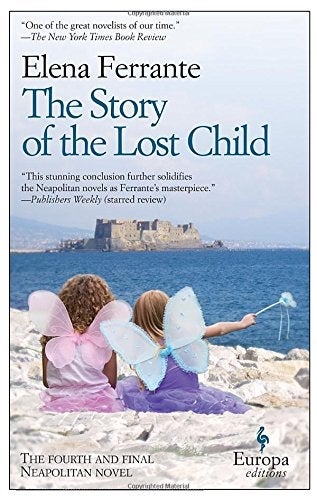The Story of the Lost Child, by Elena Ferrante - book review: A dark and voyeuristic peek into the inner world of women
‘The devastation is so intimately rendered that I couldn’t breathe’

Throughout The Story of the Lost Child, the final volume of Ferrante’s riotous, expansive “Neapolitan Novels”, the author – who famously writes under a pseudonym – weaves a description of her manifesto as a writer into the life stories of the central characters, Lila and Elena.
This manifesto involves peering into the inner world of women and saying aloud what they can barely admit to themselves. Not just telling secrets, but exposing the most morally despairing corners of life. It is the insights from these unpalatable truths that make the books so gripping. If that sounds like an Italian soap opera then in some ways it is, but the novels operate on multiple levels and what Ferrante has achieved is a perfect marriage of immense storytelling with chillingly effective literary artistry.
The Lost Child begins with Elena’s decision to leave her comfortable life in Florence and to destroy everything she has painstakingly built – career, children and marriage – for a Neapolitan man from her childhood who is never portrayed as anything other than a bad choice. What follows is the dissolution of her world brought on by the impossibility of trying to be a wife, mother and writer in mid-to-late Seventies Italy. As she falls, she obsessively details the way down – each wrong turn, each appalling consequence. She admits to loving her lover more than her own daughters. She abandons her children, returns to them, hurts people and is hurt. The emotional devastation is so intimately rendered that at times, as I read, I couldn’t breathe. I felt I was trapped in the inevitability of pain brought on by the circumstances of her social and biological destiny.
I loved these Neapolitan novels in a way I haven’t enjoyed reading for a long time, owing to the immersion in another world. We peer voyeuristically into what Elena calls the lota, a Neapolitan dialect word meaning the mud – the dirt, the meanness and baseness of the city, or of the people who come from Naples – and we see how Lila is the lota whereas Elena is for ever attempting, and failing, to escape the lota.
In a Q&A in The New York Times, Ferrante said: “I’m a storyteller. I’ve always been more interested in storytelling than writing.” While presumably autobiographical, The Lost Child is highly structured fiction. The narrative spirals. The ending links to the beginning of the first novel, My Brilliant Friend, in which Lila and Elena as children play with dolls above a cellar owned by Don Achille, a man who represents everything rotten in Naples – the legacy of fascism, masculine rage, corruption – and when Lila throws Elena’s doll into the cellar, the first act of betrayal between friends is committed, as is the first disappearance.
The motif of a lost child – sometimes a doll, or childhood itself, or a daughter, someone else’s daughter, sometimes abandoned or wilfully given away or stolen – is threaded through all of the books. It occurs in Ferrante’s earlier, shorter novels too (The Days of Abandonment, The Lost Daughter) and it provides a central psychological anchor to the gossipy plot, the filmic love story, the tale of bludgeoned marriage, deaths, neighbourhood girls and bad men. To lose a child is one of the biggest fears of all. To be the lost child is worse.
Elena brings up every objection to the entire endeavour that a reader might have. If it is so-called auto-fiction then why is it not a mess, like life? If it is the story of a friendship then isn’t every word a betrayal to that friend? If it is sincere and authentic, why is the author’s name on the cover a lie? Borders between autobiography and fiction dissolve, just as the edges of Lila (both her sanity and her body) blur, and Elena provides a continual commentary on this process. Rather than this being annoying and meta, the effect is to make the writing feel alive. The coolness of tone contrasts with the intensity of the emotion, so that, for example, when she writes of the shame of making her daughters choose between her or their grandparents, the simply written words almost burn on the page.
Lila’s obsession with the architecture and history of Naples does not ring as true as earlier depictions of her complex, manipulative character. It’s a little contrived (a fact on which Elena comments), as is the return to a significant event from the very beginning. But this neatly sewn-up ending to what has felt unnervingly true provides us with welcome relief. Ferrante gives us a coherent pattern that we don’t have in life.
It is the fictional element that finally undid me. In the end, I do not care who the real Elena Ferrante is; I am only interested in the story, and I am guessing that is what she would want.
Suzanne Joinson is the author of ‘A Lady Cyclist’s Guide to Kashgar’ and the forthcoming ‘The Photographer’s Wife’ (both Bloomsbury)
Join our commenting forum
Join thought-provoking conversations, follow other Independent readers and see their replies
Comments